Why you can trust Tom's Hardware
As an HDR-capable gaming monitor, the AG493UCX should deliver extended color along with solid grayscale and gamma accuracy. It does so and can be enjoyed without calibration, but there are gains had from a few adjustments.
Grayscale and Gamma Tracking
We describe our grayscale and gamma tests in detail here.
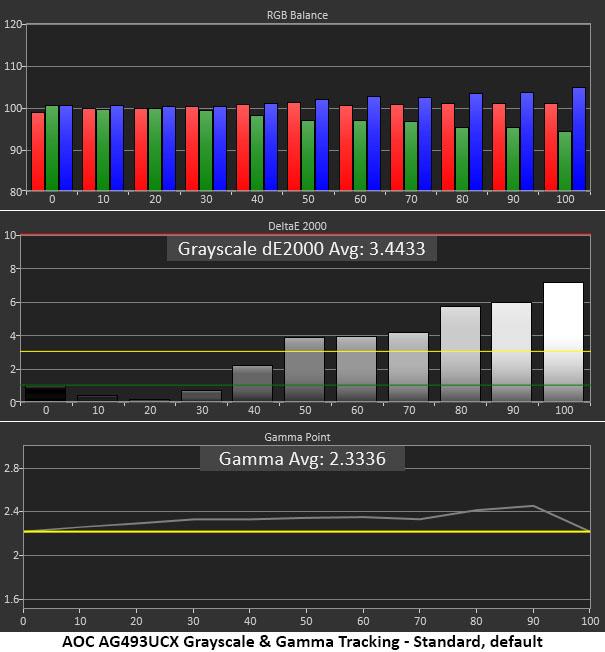
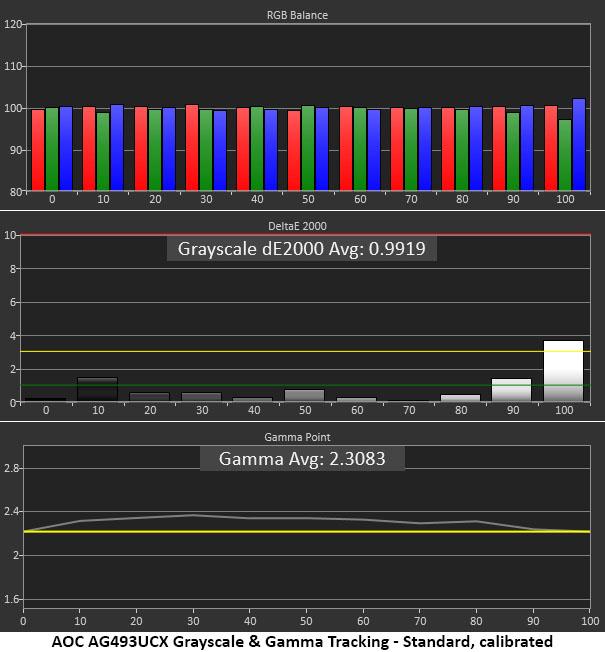
Default grayscale tracking isn’t too bad with just a few errors when brightness is at 50-100%. The decline in green meant some highlights looked a little purple. Gamma runs a little dark, but that’s acceptable in a high-contrast VA monitor. Although we’d prefer it track at 2.2 instead of 2.3, this error didn’t greatly impact the image
The second chart shows results after our calibration (see our recommended settings on page 2). Calibration made all visible errors go away unless at 100% brightness, which is still a bit over the 3 Delta E (dE) threshold, meaning you’ll be able to see the error with the naked eye. You might see a purple tint in the brightest highlights, but most image material won’t be affected. Gamma is the same at just over 2.3 average.
We tried the other two presets, but they were far too light and only served to wash out the picture.
Comparisons
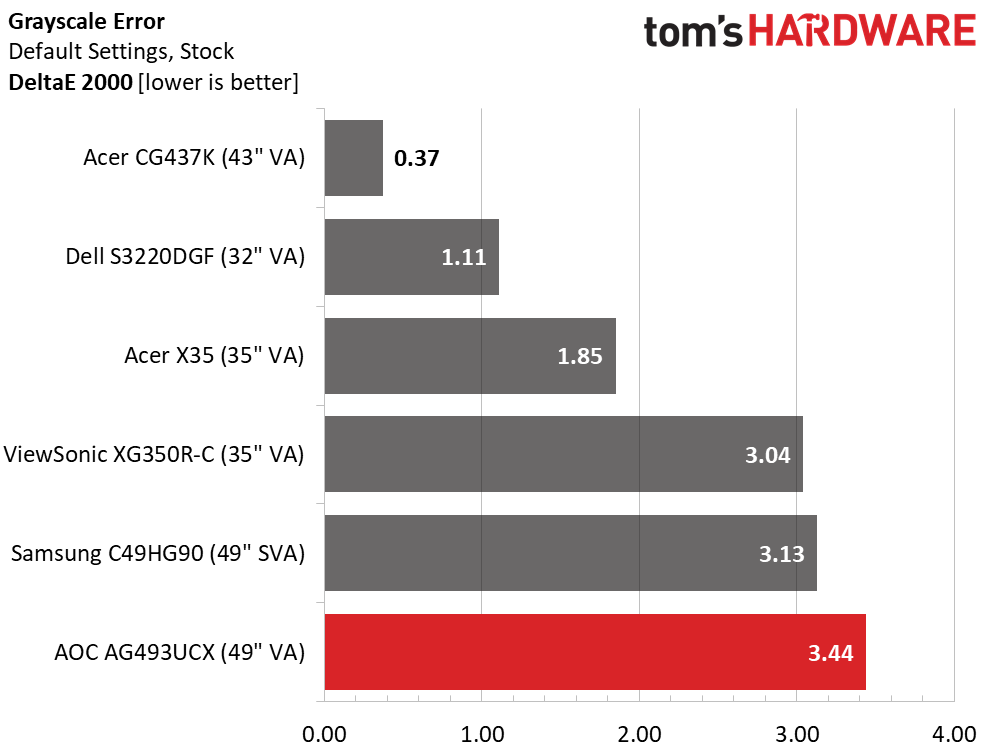
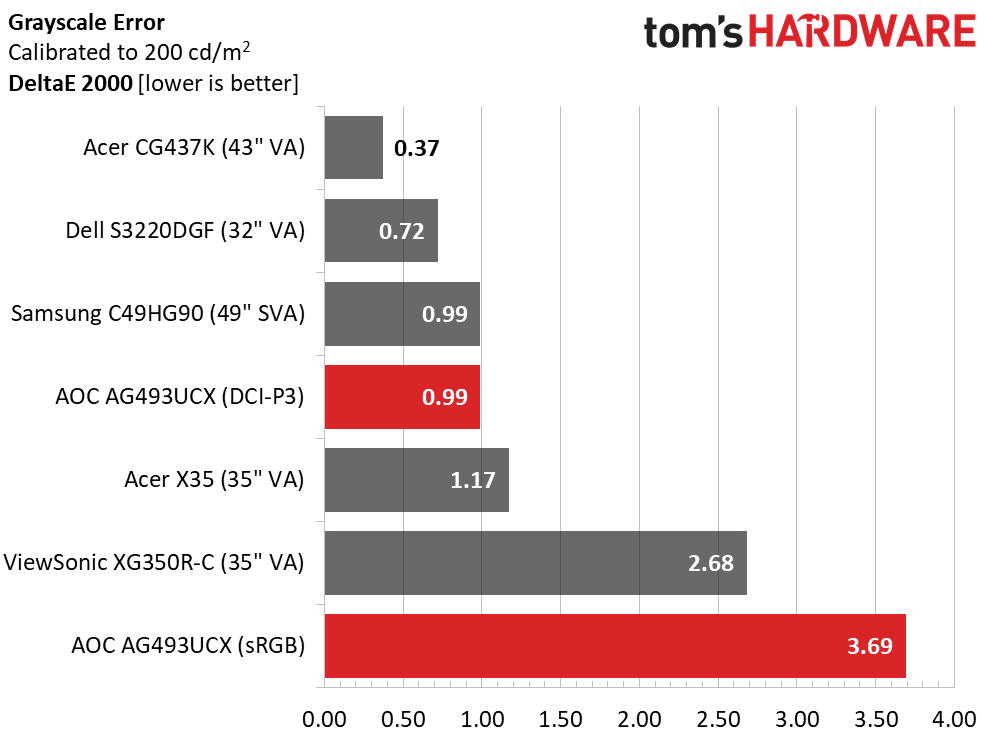
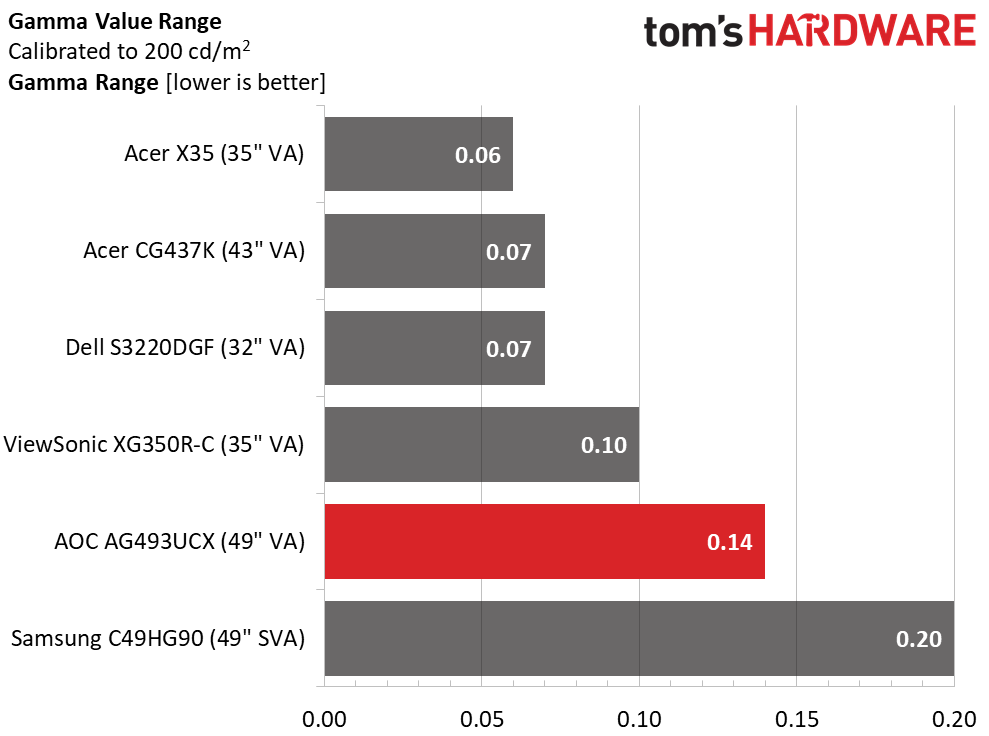
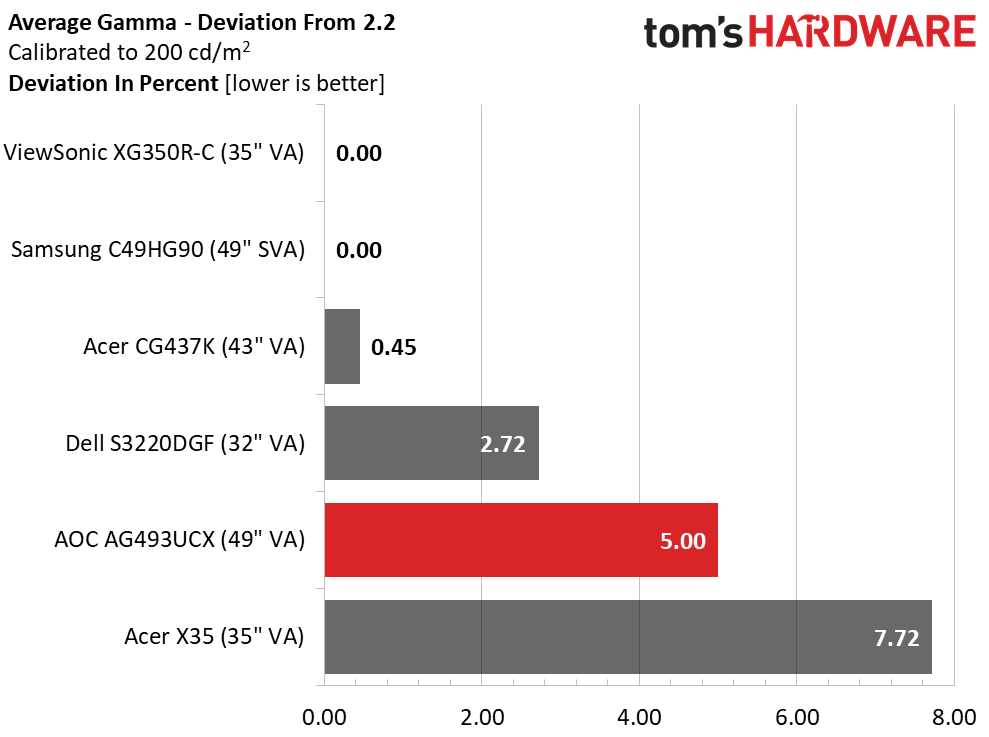
An average grayscale error of 3.44dE isn’t screaming for calibration, but we recommend performing one anyway. You can see the AG493UCX got a significant improvement in the second chart with a pro-level 0.99dE score.
If you want to work or play in the sRGB realm, the grayscale error is a reasonable 3.69dE with no adjustment possible.
Get Tom's Hardware's best news and in-depth reviews, straight to your inbox.
Though gamma is a bit darker than 2.2, the AG493UCX delivered tight tracking with a tiny 0.14 range of values. That’s on par with the best displays we’ve tested. All the monitors here have excellent gamma.The 2.31 average value represents a 5% deviation, which isn’t as good as the very best but is acceptable for a high-contrast VA panel such as this.
Color Gamut Accuracy
For details on our color gamut testing and volume calculations, click here.
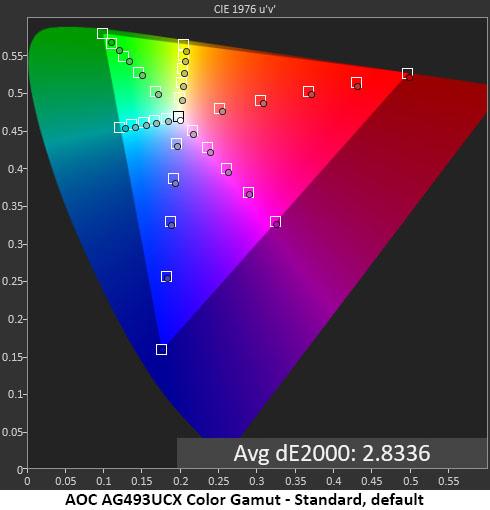
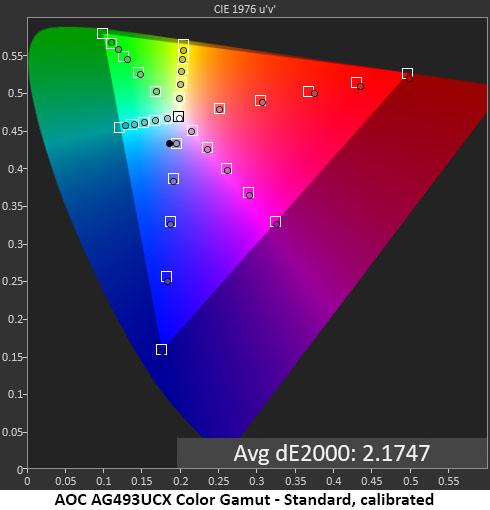
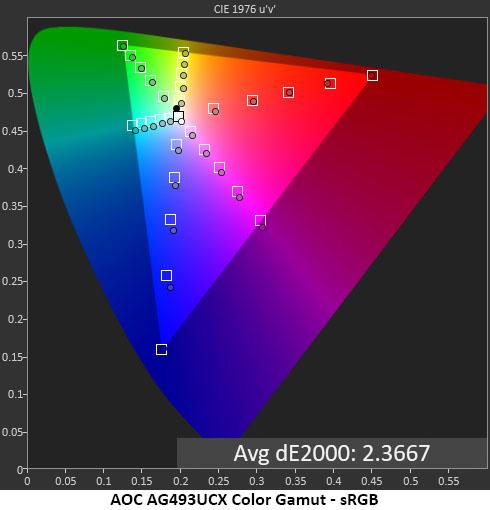
The AG493UCX is set by default to display its full native DCI-P3 color gamut. You can choose sRGB from the color temp options to use the smaller spec if you wish.
Out-of-the-box color accuracy was quite good with no visible errors and a solid average of 2.83dE. Calibration reduced that to 2.17dE. The only shortfall is in the green primary, which came up a bit short of the full DCI green.
sRGB mode measured very well with a slight hue error in cyan and a little over-saturation of the inner blue targets.
Comparisons
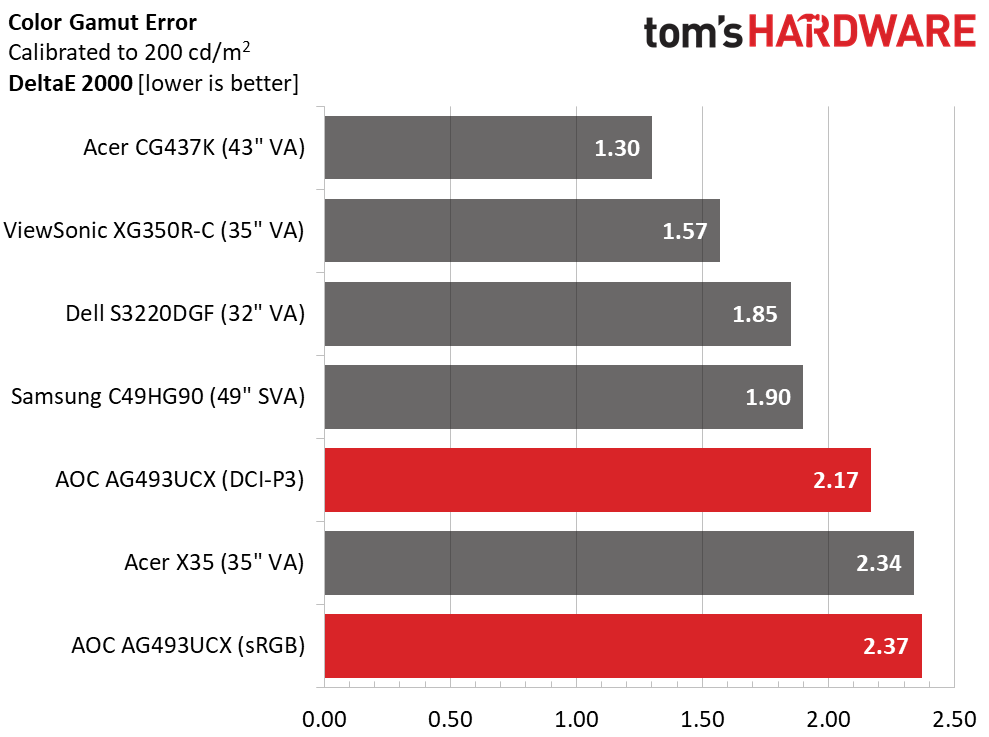
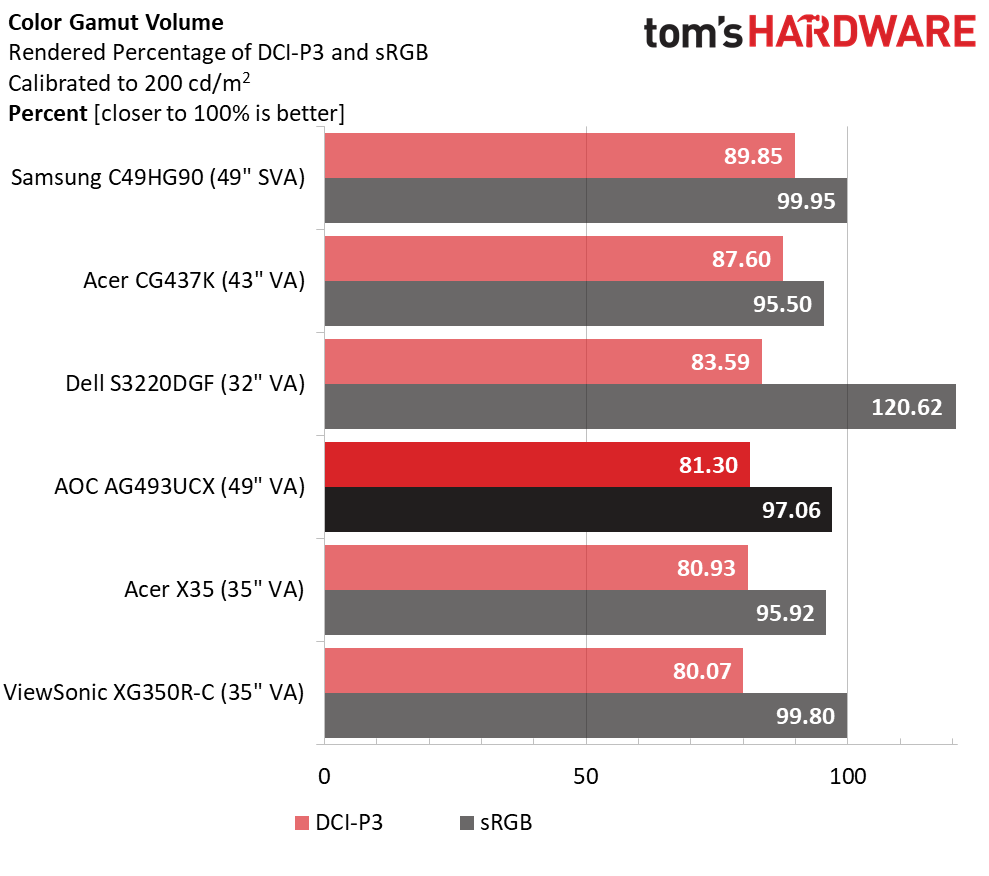
We have no complaints about the AG493UCX’s color accuracy. Even without calibration, its gamut is very close to all targets. Only the green primary is a bit under-saturated from the full DCI-P3 spec. sRGB is also completely usable, even for those engaged in color-critical work.
According to our testing, the AG493UCX covers 81.3% of the DCI-P3 gamut volume, which is crucial for HDR. That’s near the low end of the scale among the HDR monitors we’ve reviewed. However, green is the only primary that comes up short. The extra color available with HDR was completely visible on the AG493UCX.
With sRGB volume at an excellent 97.06%, you can work on photos with precision, but we recommend a custom profile for best results.
MORE: Best Gaming Monitors
MORE: How We Test Monitors
MORE: All Monitor Content
Current page: Grayscale, Gamma and Color
Prev Page Brightness and Contrast Next Page HDR Performance
Christian Eberle is a Contributing Editor for Tom's Hardware US. He's a veteran reviewer of A/V equipment, specializing in monitors. Christian began his obsession with tech when he built his first PC in 1991, a 286 running DOS 3.0 at a blazing 12MHz. In 2006, he undertook training from the Imaging Science Foundation in video calibration and testing and thus started a passion for precise imaging that persists to this day. He is also a professional musician with a degree from the New England Conservatory as a classical bassoonist which he used to good effect as a performer with the West Point Army Band from 1987 to 2013. He enjoys watching movies and listening to high-end audio in his custom-built home theater and can be seen riding trails near his home on a race-ready ICE VTX recumbent trike. Christian enjoys the endless summer in Florida where he lives with his wife and Chihuahua and plays with orchestras around the state.
-
JohnBonhamsGhost this thing is insanely wide, maybe too wide. though i would love to try it.Reply
how many games out there do you think would actually support 32:9? -
remosito Too wide for my tastes. Still waiting on a 5040x2160p 21:9 50incher with VRR and 120Hz HDR.Reply -
A Stoner Reply
I dunno, at 50 inches wide that would be a very tall monitor, you would get crane neck syndrome using it...remosito said:Too wide for my tastes. Still waiting on a 5040x2160p 21:9 50incher with VRR and 120Hz HDR. -
JohnBonhamsGhost Replyremosito said:Too wide for my tastes. Still waiting on a 5040x2160p 21:9 50incher with VRR and 120Hz HDR.
it can be a nice gaming solution but you need to be sitting quite a few feet away. had a 40.5" as my secondary gaming display for a year or two and it was nice with the Corsair Lapdog keyboard/mouse setup and my chair pushed back ~4'.A Stoner said:I dunno, at 50 inches wide that would be a very tall monitor, you would get crane neck syndrome using it... -
Ellimist This looks like its based off the samsung panel. The CRG90 which is 120hz same res but with quantum dot. Lets see a review of that. Its not really a replacement for the CHG90 like mentioned considering the Samsung CRG9 has been out for quite some time.Reply
The only downside to these is that you can't run 120hz and 10bit color. you max out at 100hz and 10bit if you don't want to use compression because of DP1.4. While its not a big downer I'm surprised you missed it in the negatives.
The next Samsung ultrawide the G9 solves all the problems with color and refresh because it uses DP2.0 so it has the bandwidth. the only thing I'm not sure about is the 1000R curve as I find the 1800R curve good for productivity use as well as gaming. i'm not sure if 1000R will meet my productivity needs or not. -
Brillis Wuce This product is DOA.Reply
Samsung CRG9 has the same specs, but with Quantum Dot and HDR1000.
It's marked up at the moment ($1287), but I've seen it drop down to $1100 on sale.
I'd gladly sacrifice the 10bit color for a full HDR1000. -
mac_angel I'm happy with my three Samsung RU8000 55" in surround mode. about 10' and 7680x1440@120Hz including HDRReply -
CharlesVee ReplyJohnBonhamsGhost said:this thing is insanely wide, maybe too wide. though i would love to try it.
how many games out there do you think would actually support 32:9?
Almost all current and last gen 3D games, 2D not so much, they're usually confined to 16:9. I was running a triple monitor surround setup all the way back in 2013, that's 7680x1440 and I got almost every game I played to run that way using simple tools like Flawless Widescreen, even the original Bioshock.
As for this monitor, it's very close to what I'm looking for, I'll probably end up buying either this or the Samsung equivalent. I don't want multiple monitors, I already sold the other two quite a while ago and now I'm suffering the productivity consequences of being confined to one screen! It's frustratingly constricting. The only thing I'd like is for it to be taller than a 27", same ratio just a few inches larger, but I don't think a monitor like that will be coming any time soon and I've already waited two years so I'm going to settle.